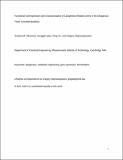| dc.contributor.author | Qiao, Kangjian | |
| dc.contributor.author | Xu, Peng | |
| dc.contributor.author | Stephanopoulos, Gregory | |
| dc.contributor.author | Silverman, Andrew Michael | |
| dc.date.accessioned | 2017-03-04T00:08:51Z | |
| dc.date.available | 2017-03-04T00:08:51Z | |
| dc.date.issued | 2016-02 | |
| dc.date.submitted | 2016-01 | |
| dc.identifier.issn | 0175-7598 | |
| dc.identifier.issn | 1432-0614 | |
| dc.identifier.uri | http://hdl.handle.net/1721.1/107181 | |
| dc.description.abstract | Single cell oil (SCO) is an attractive energy source due to scalability, utilization of low-cost renewable feedstocks, and type of product(s) made. Engineering strains capable of producing high lipid titers and yields is crucial to the economic viability of these processes. However, lipid synthesis in cells is a complex phenomenon subject to multiple layers of regulation, making gene target identification a challenging task. In this study, we aimed to identify genes in the oleaginous yeast Yarrowia lipolytica whose overexpression enhances lipid production by this organism. To this end, we examined the effect of the overexpression of a set of 44 native genes on lipid production in Y. lipolytica, including those involved in glycerolipid synthesis, fatty acid synthesis, central carbon metabolism, NADPH generation, regulation, and metabolite transport and characterized each resulting strain’s ability to produce lipids growing on both glucose and acetate as a sole carbon source. Our results suggest that a diverse subset of genes was effective at individually influencing lipid production in Y. lipolytica, sometimes in a substrate-dependent manner. The most productive strain on glucose overexpressed the diacylglycerol acyltransferase DGA2 gene, increasing lipid titer, cellular content, and yield by 236, 165, and 246 %, respectively, over our control strain. On acetate, our most productive strain overexpressed the acylglycerol-phosphate acyltransferase SLC1 gene, with a lipid titer, cellular content, and yield increase of 99, 91, and 151 %, respectively, over the control strain. Aside from genes encoding enzymes that directly catalyze the reactions of lipid synthesis, other ways by which lipogenesis was increased in these cells include overexpressing the glycerol-3-phosphate dehydrogenase (GPD1) gene to increase production of glycerol head groups and overexpressing the 6-phosphogluconolactonase (SOL3) gene from the oxidative pentose phosphate pathway to increase NADPH availability for fatty acid synthesis. Taken together, our study demonstrates that the overall kinetics of microbial lipid synthesis is sensitive to a wide variety of factors. Fully optimizing a strain for single cell oil processes could involve manipulating and balancing many of these factors, and, due to mechanistic differences by which each gene product investigated here impacts lipid synthesis, there is a high likelihood that many of these genes will work synergistically to further increase lipid production when simultaneously overexpressed. | en_US |
| dc.description.sponsorship | United States. Dept. of Energy. Office of Biological and Environmental Research (Genomic Science Program (U.S.)) | en_US |
| dc.publisher | Springer Berlin Heidelberg | en_US |
| dc.relation.isversionof | http://dx.doi.org/10.1007/s00253-016-7376-0 | en_US |
| dc.rights | Creative Commons Attribution-Noncommercial-Share Alike | en_US |
| dc.rights.uri | http://creativecommons.org/licenses/by-nc-sa/4.0/ | en_US |
| dc.source | Springer Berlin Heidelberg | en_US |
| dc.title | Functional overexpression and characterization of lipogenesis-related genes in the oleaginous yeast Yarrowia lipolytica | en_US |
| dc.type | Article | en_US |
| dc.identifier.citation | Silverman, Andrew M., Kangjian Qiao, Peng Xu, and Gregory Stephanopoulos. “Functional Overexpression and Characterization of Lipogenesis-Related Genes in the Oleaginous Yeast Yarrowia Lipolytica.” Applied Microbiology and Biotechnology 100, no. 8 (February 26, 2016): 3781–3798. | en_US |
| dc.contributor.department | Massachusetts Institute of Technology. Department of Chemical Engineering | en_US |
| dc.contributor.mitauthor | Qiao, Kangjian | |
| dc.contributor.mitauthor | Xu, Peng | |
| dc.contributor.mitauthor | Stephanopoulos, Gregory | |
| dc.contributor.mitauthor | Silverman, Andrew Michael | |
| dc.relation.journal | Applied Microbiology and Biotechnology | en_US |
| dc.eprint.version | Author's final manuscript | en_US |
| dc.type.uri | http://purl.org/eprint/type/JournalArticle | en_US |
| eprint.status | http://purl.org/eprint/status/PeerReviewed | en_US |
| dc.date.updated | 2016-05-23T12:09:42Z | |
| dc.language.rfc3066 | en | |
| dc.rights.holder | Springer-Verlag Berlin Heidelberg | |
| dspace.orderedauthors | Silverman, Andrew M.; Qiao, Kangjian; Xu, Peng; Stephanopoulos, Gregory | en_US |
| dspace.embargo.terms | N | en |
| dc.identifier.orcid | https://orcid.org/0000-0002-0999-8546 | |
| dc.identifier.orcid | https://orcid.org/0000-0001-6909-4568 | |
| dc.identifier.orcid | https://orcid.org/0000-0001-7209-7786 | |
| mit.license | OPEN_ACCESS_POLICY | en_US |
| mit.metadata.status | Complete | |
